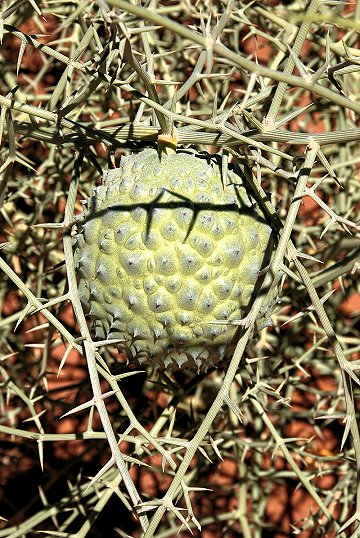
|
|
Nara - Desert melon
(Acanthosicyos horridus ).
|
Nara - Desert melon - Acanthosicyos horridus
Acanthosicyos horridus is an unusual melon of the botanical family Cucurbitaceae,
that is endemic to the Namib desert. In English it is known as Nara, butter-nuts, or
butterpips. The genus name derives from the Greek words "akantha" for thorn and "sykios" for cucumber or gourd.
This delicious desert melon is native to southern Angola, Namibia and western South Africa, where it grows along the Atlantic coast in places with ground water access in one of the world's driest deserts. It forms a fiercely spiny shrub to about 1 m tall that can cover vast areas and reach ages of 100 years or more.
Naras is a low-growing but widely spreading herbaceous perennial. It is a typical desert plant, with an extensive far-ranging root system.
It is a dioecious, leafless, phreatophyte (meaning its roots penetrate deep down to water near the water table) that is found in sandy deserts but not stony plains, in areas with access to ground water such as ephemeral rivers and paleochannels, where sand accumulating in the shelter of its stems can form hummocks up to 1000–1500 m2 in area and 4 meters in height. Its stems may rise more than a meter above the hummocks, while its system of thick taproots can extend up to 50 m downward. The plant is leafless, so modified stems and spines 2–3 centimetres long serve as the photosynthetic "organs" of the plant. The plant can survive many years without water.
Its sand-binding characteristics also help nara form microclimate within the desert dunes. These microclimates provide food and shelter for a variety of vertebrates. Presence of the nara plant is associated with significantly increased soil microdiversity likely due to the shade it provides and the attraction of foraging mammals which contribute to organic matter.
Acanthosicyos horridus typically occurs in the absence of other vegetation due to the harshness of the climate,[4] though Eragrostis spinosa and Stipagrostis sabulicola grasses may grow between its hummocks. It is regarded as a keystone species because its melons, seeds, shoots, and flowers are food sources for beetles, gemsbok, and ostrich, while small rodents such as Rhabdomys pumilio, Desmodillus auricularis, and Thallomys nigricauda take shelter amid the spiny tangle of its stems. The katydid Acanthoproctus diadematus feeds on the plant, moving between different bushes at night.
The melon fruits average 1 kg, and are pale green and spiny. Within it has a sweet, aromatic, watery, yellow-orange pulp. The large edible seeds, white to cream in color, are known as butter-nuts or butterpips. These have been exported for use in baked goods.
Before the introduction of maize into southern Africa, this was a traditional staple food for the local people. Archaeological evidence indicates that it has been a staple food for at least
8.000 years, and was transported and perhaps even traded that long ago. It has not been domesticated and attempts to introduce it elsewhere have not been successful. It is still much valued as a food by the local peoples for some of whom it can be their main food for about 4 months of the year.
The fruit serves as a food source for Nama people from February to April and August to September.
They also sell some of the seeds in the markets of nearby towns.
Fruits are edible raw, cooked or preserved. Juicy, with a pleasant, sweet-acid flavour.
Ripe fruits are collected and either buried in the soil or left in the sun for softening, after which they are peeled and then boiled until the seeds become loose. The pulp is allowed to thicken and turns into a dark orange colour. After separating the seeds, the thick remaining pulp is poured out and allowed to dry in the sun. It solidifies in a few days, forming flat leathery cakes, called ‘goa-garibeb’, which are then cut into strips or rolled up for storage. These fruity rolls have good keeping quality and can be chewed or added to porridge for the remainder of the year.
Seed - raw or cooked. Eaten roasted or boiled, they can also be stored for later use. They can be ground into flour for cooking with other dishes. They are a good substitute for almonds, and have been exported to bakeries in Cape Town for use in confectionery. The kernel has a soft consistency like butter. The seeds contain about 45% oil. The seed is up to 15mm long.
An edible oil is obtained from the seed. Recently, the seeds have been used in confectionery.
The bitter roots have medicinal value. Either chewed or made into a decoction, they are used to treat nausea, stomach-ache, venereal diseases, kidney problems, arteriosclerosis and chest pains.
The crushed root mixed with fat is used to heal wounds.
The fresh fruit is said to relieve stomach pains.
Oil from the raw or boiled seeds is used as a skin moisturizer and to protect the skin from sunburn.
Source:
https://en.wikipedia.org/wiki/Acanthosicyos_horridus
https://tropical.theferns.info/viewtropical.php?id=Acanthosicyos+horridus
